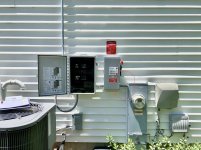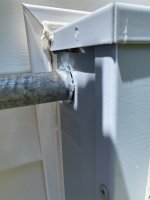SolarPro
Senior Member
- Location
- Austin, TX
What do you make of this conduit entry detail?
This is a pedestal-type meter base for an underground service. There are some oversized OEM knockouts below the meter. But the installer opted to enter at the top of the box.
That wouldn't have been my first choice. I certainly wouldn't enter a standard meter base in this fashion.
But does the code prohibit this? If so, what is the relevant code reference?
Thanks in advance.


This is a pedestal-type meter base for an underground service. There are some oversized OEM knockouts below the meter. But the installer opted to enter at the top of the box.
That wouldn't have been my first choice. I certainly wouldn't enter a standard meter base in this fashion.
But does the code prohibit this? If so, what is the relevant code reference?
Thanks in advance.



